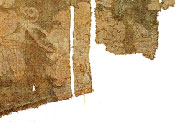 |
 |
||||||||||||||||
 |
|||||||||||||||||
 |
|||||||||||||||||
| Classified Glossary | |||||||||||||||||
 |
|||||||||||||||||
 |
|||||||||||||||||
| 32. 1Lampas Lampas (tejiejin) is a figured weave in which a pattern, composed of patterning wefts (wenwei) bound by an extra binding warp (tejiejing), is added to a foundation weave (dizuzhi) formed by a foundation warp (dijing) and a foundation weft (diwei). The pattern wefts are bound by the extra binding warp forming a binding weave (gujiezuzhi) which could be either tabby or twill and is supplementary to the ground weave. (see CIETA 1964). Lampas weave appeared in China during Yuan dynasty as the nasij woven with gold threads, then as Song-style lampas (songshijin) during the Ming and Qing dynasties. 33. 1Double weave The warp in double weave (shuangcengzuzhi) is composed of two series of ends, each interlacing with its own weft forming two layers of textile. The binding of each textile is usually the same, most commonly tabby, but other and different bindings may also be used (see CIETA 1964). Early double weaves are always patterned double weaves, in which the two textiles change position as required by the pattern. In China, double-weave textiles made of wool appeared around the 3rd century, then were applied to silk during the 7th to 8th century. In the Ming and Qing dynasties there was a special Chinese name ganji for it. 34. 1Carpet Carpet (zairongditan) with pile is created with different kinds of knots, including: 1. closed knot (8-zijie) or Turkish knot; 2.open knot (kaikoujie), also called the Persian knot; 3. U-knot (U-ziyingjie), also called the Spanish knot. (see CIETA 1964) |
|||||||||||||||||
| THE BOOK | |||||||||||||||||
| AUTHOR | |||||||||||||||||
| CONTENTS | |||||||||||||||||
| ORDER | |||||||||||||||||
| CONTACT | |||||||||||||||||
| LINKS | |||||||||||||||||